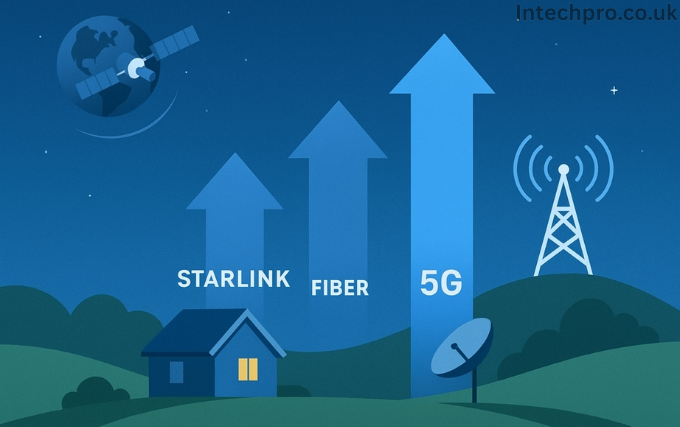Understanding Starlink’s Role in Modern Internet Connectivity
Starlink has become one of the most talked-about internet solutions in 2025, especially for users living in rural or underserved regions. Built by SpaceX, the satellite-based system is designed to deliver high-speed internet anywhere on the planet. As demand for fast and reliable connectivity continues to rise, Starlink is often compared to other leading technologies like fiber-optic broadband and 5G wireless networks. Understanding how Starlink performs against these competitors helps users make better decisions about which service best fits their needs.
Starlink Internet Speed Performance in 2025
Starlink’s internet speed in 2025 has improved significantly compared to its early launch years. Many users now experience download speeds ranging from 100 Mbps to 220 Mbps, depending on location and network congestion. Upload speeds also remain strong, averaging between 20 Mbps and 40 Mbps. Latency has been one of the major improvements, dropping to around 25–40 ms for most regions. These numbers place Starlink in a competitive position, offering speeds much better than traditional satellite internet and fast enough for streaming, gaming, and video conferencing without major interruptions.
How Fiber Internet Speed Compares to Starlink
Fiber-optic internet is often considered the gold standard for both speed and stability. In 2025, fiber still outperforms most other internet technologies because it uses light signals through glass cables, making it extremely fast and reliable. Many fiber providers now offer speeds ranging from 500 Mbps to 10 Gbps, with near-zero latency. When comparing fiber to Starlink, the biggest difference is consistency. Fiber maintains its speed regardless of weather, location, or network congestion. Starlink, on the other hand, can experience slight fluctuations depending on satellite position and user density. However, for users in remote areas where fiber installation is impossible, Starlink remains the strongest alternative.
5G Internet Speed and Its Strengths
5G networks continue to expand worldwide in 2025, offering ultra-fast wireless internet speeds that can rival and sometimes exceed fiber. In ideal conditions, 5G can deliver speeds between 300 Mbps and 2 Gbps with very low latency. However, the performance depends heavily on how close a user is to a 5G tower. Urban areas receive the fastest speeds, while rural areas often get only mid-band 5G, which ranges between 50 Mbps and 200 Mbps. Compared to Starlink, 5G can be faster in cities but far less reliable in remote areas. This makes 5G an excellent option for mobile users and households in urban environments but not always the best for rural communities lacking strong infrastructure.
Factors That Influence Starlink Internet Speed
Several factors affect Starlink’s internet speed, and understanding them can help users optimize their experience. Weather conditions can impact satellite signals, although Starlink’s newer technology has reduced this issue significantly. User congestion is another factor because each satellite serves a limited number of users at a time. Additionally, obstructions such as trees or buildings can interfere with the dish’s connection to the sky. Starlink continually launches new satellites and upgrades its ground equipment, which helps reduce speed drops and ensures better overall performance throughout the year. These improvements make Starlink increasingly competitive with other major internet technologies.
Starlink vs Fiber: Which Is Better for Home Users?
When comparing Starlink and fiber for home internet use, fiber remains the top choice where available. It offers unmatched speed, stability, and reliability, especially for heavy internet users who stream in 4K, game online, or work remotely. However, fiber is still limited in coverage. Installation can be expensive or unavailable in many regions worldwide. Starlink bridges this gap by providing a strong alternative that delivers high-speed internet even in the most remote environments. For users without access to fiber, Starlink is often the best possible choice, giving them speeds that rival mid-tier fiber plans.
Starlink vs 5G: Which Performs Better Overall?
Starlink and 5G both offer impressive performance, but their strengths differ based on location and usage. In cities, 5G typically outperforms Starlink with higher bandwidth and lower latency. It is ideal for mobile users, smartphones, and households close to major towers. In suburban and rural areas, however, 5G coverage becomes inconsistent. This is where Starlink becomes more reliable, offering stable high-speed internet regardless of local infrastructure. For users needing a reliable home connection in areas lacking 5G coverage, Starlink remains the stronger option. For users in dense urban areas, 5G may deliver better performance if available at strong signal levels.
Future Outlook for Starlink Internet Speed
Starlink’s future looks promising as SpaceX continues to expand its satellite constellation and upgrade communication technologies. The introduction of laser-linked satellites has reduced latency and improved global coverage. More satellites in orbit also mean lower congestion and higher speeds for users. Over the next few years, Starlink aims to offer speeds that can consistently reach 300 Mbps or more, closing the performance gap with fiber and high-band 5G. As technology advances, users can expect Starlink to become even more competitive in speed, stability, and affordability.
Final Thoughts
In 2025, Starlink internet speed stands strong compared to fiber and 5G. While fiber remains the fastest and most reliable option overall, it is limited in availability. In urban areas with full 5G coverage, wireless networks can outperform both fiber and Starlink under ideal conditions. However, Starlink shines where other technologies struggle, offering high-speed internet in rural, remote, and underserved locations. It successfully fills the accessibility gap and continues to improve each year. As SpaceX deploys more satellites and enhances technology, Starlink is on track to become one of the most dependable internet solutions worldwide.


